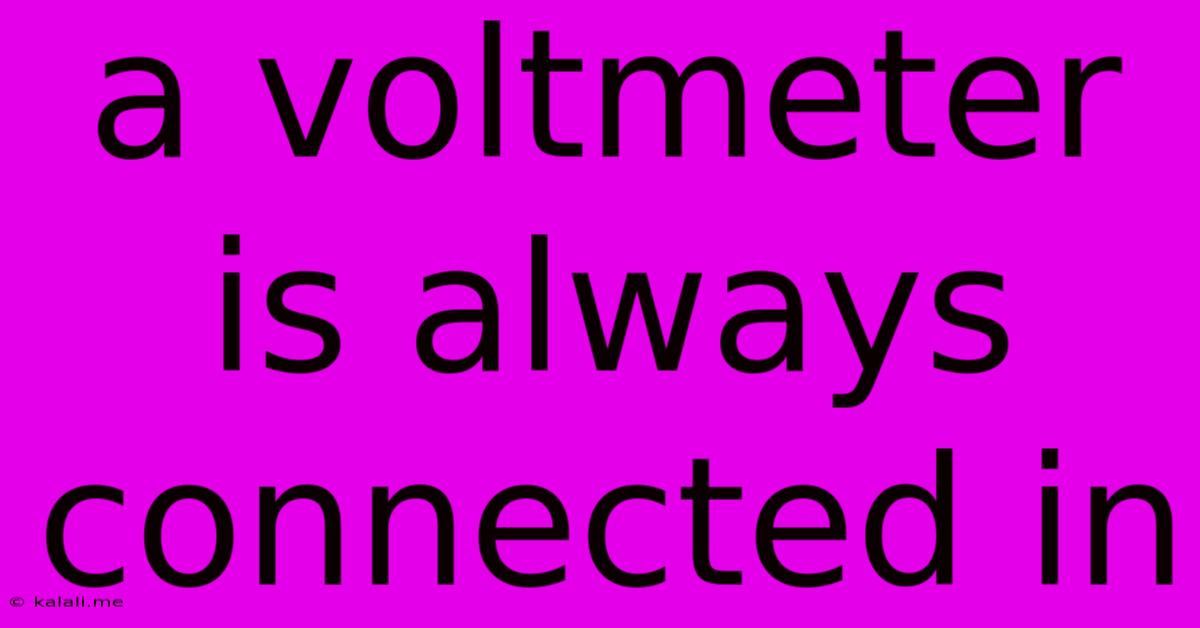A Voltmeter Is Always Connected In
Kalali
Jun 15, 2025 · 3 min read

Table of Contents
A Voltmeter is Always Connected in Parallel: Understanding Voltage Measurement
A voltmeter is an essential tool for anyone working with electronics, used to measure the electrical potential difference between two points in a circuit. Understanding how to properly connect a voltmeter is crucial for accurate readings and avoiding damage to your equipment. This article will explain why a voltmeter is always connected in parallel, and detail the implications of incorrect connections.
Why Parallel Connection is Essential
A voltmeter measures the voltage across a component or section of a circuit. Voltage, or potential difference, is the electrical pressure that drives the flow of current. To measure this pressure, the voltmeter needs to be placed across the component, not in series with it. This is because connecting a voltmeter in series would significantly alter the circuit's resistance, leading to inaccurate readings and potentially damaging the meter itself.
Here's why a parallel connection is crucial:
-
Minimal Current Draw: Voltmeters have a very high internal resistance. This high resistance ensures that only a negligible amount of current flows through the meter itself. Connecting it in parallel minimizes disruption to the circuit's normal operation. In essence, it acts as a passive observer.
-
Measuring Potential Difference: A parallel connection allows the voltmeter to measure the potential difference across two points directly. The high resistance ensures that the voltage drop across the voltmeter is almost identical to the voltage drop across the component being measured.
-
Avoiding Circuit Disruption: Connecting a voltmeter in series would introduce a significant additional resistance, drastically reducing the current flowing through the circuit. This could lead to incorrect readings, malfunctioning of other components, and potential damage to the meter itself.
Understanding the Implications of Incorrect Connections
Connecting a voltmeter in series will almost certainly result in inaccurate readings. The added resistance of the meter will substantially alter the circuit's characteristics, significantly affecting voltage drops across other components. Furthermore, the high resistance of the voltmeter could even overload the circuit, resulting in damage to the device under test or the voltmeter itself.
Practical Considerations for Voltmeter Use
-
Always ensure the voltmeter's range is appropriate for the voltage being measured. Selecting a range too low can damage the meter, while choosing a range too high might result in an inaccurate reading with poor resolution.
-
Properly identify the positive and negative terminals of both the voltmeter and the circuit. Connecting the leads incorrectly can lead to an inaccurate reading or damage the meter.
-
Use appropriate test leads that are in good condition. Damaged leads can cause inaccurate readings or even create safety hazards.
-
Never connect a voltmeter across a high-voltage source without appropriate safety precautions. High voltage can be lethal, and proper safety procedures must be followed to avoid injury.
By understanding the fundamental principle of connecting a voltmeter in parallel, you can ensure accurate voltage measurements and avoid damaging your equipment. Remember that safety is always paramount when working with electrical circuits. Always take appropriate precautions and follow safety guidelines.
Latest Posts
Latest Posts
-
How To Create A Joint Probability Table
Jun 15, 2025
-
What Organelles Contain Their Own Dna
Jun 15, 2025
-
Stevens Institute Of Technology Average Sat
Jun 15, 2025
-
Moment Of Inertia Of A T Section
Jun 15, 2025
-
What Is The Prime Factorization Of 216
Jun 15, 2025
Related Post
Thank you for visiting our website which covers about A Voltmeter Is Always Connected In . We hope the information provided has been useful to you. Feel free to contact us if you have any questions or need further assistance. See you next time and don't miss to bookmark.